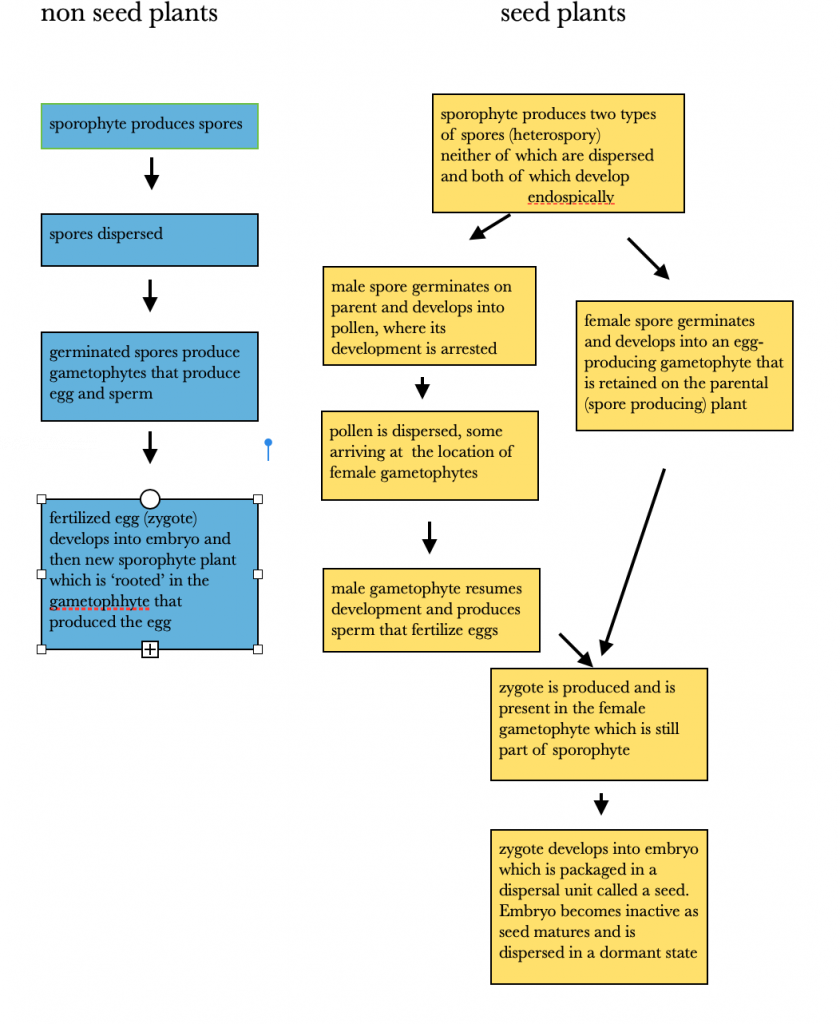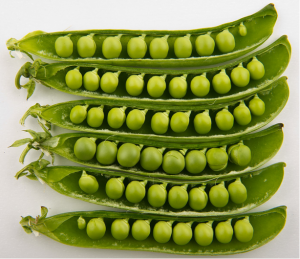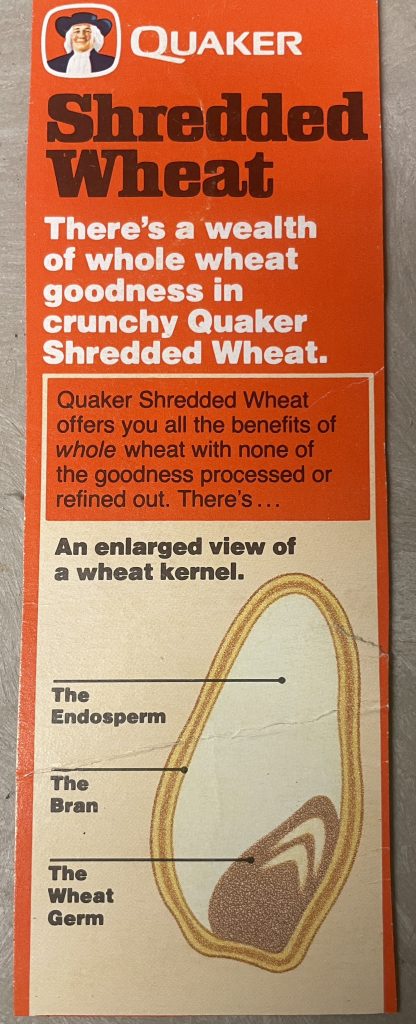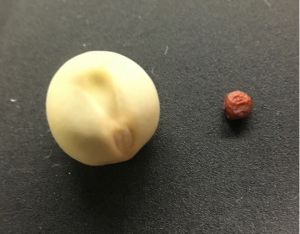Chapter 14: The Development of Seeds
- Fig. 1 Familiar seeds of pea, corn and bean have been selected for thousands of years for large size.
- Fig. 2 Many seeds are much smaller than the pea, corn, or bean seed. This figure compares a pea seed to a typical mustard seed.
Superficially, the production of seeds (Fig. 1-2) resembles the production of offspring in familiar animals: inside a diploid parent there develops a member of the ‘next generation’, which is nurtured inside its parent during the critical early stages of development and then is deposited outside its parent to finish its life. But appreciate that all plants exhibit an alternation of generations, so if a diploid (sporophyte) plant produces a new diploid (sporophyte) plant in a seed, one must account for the haploid gametophyte generation that had to come in between the two sporophyte generations. And one must also appreciate that seeds are NOT a substitute for spores, in fact, spores are critical to the production of seeds. The appearance of seeds (both in the sense of evolution and in the sense of development) is a complex story, one that involves the pattern of ‘alternation of generations’ shown in all plants. In light of this pattern, seeds represent a ‘babushka’ (Russian doll) with multiple generations found inside each other. An appreciation of this ‘generation within a generation’ is essential in understanding ‘how seeds came to be’ both evolutionarily and developmentally.
While it was long assumed that a structure as complex as seeds evolved once, many now feel that seeds evolved multiple times. Seeds therefore may represent an example of convergent evolution, where multiple lines have converged on a common feature. Whether or not this is actually the case, we can cite several features that allowed seeds to evolve and some of these features are exhibited in groups that do not produce seeds. Central to the appearance of seeds, in both a developmental and evolutionary sense, is the appearance of ovules, dynamic entities whose composition changes, ultimately ending up as a seed. In this chapter, we consider the transformations in the life cycle of plants that allowed for the development of seeds. In the next chapter, we consider the specific structures and patterns seen in conifers and flowering plants. Although we are focused on the seed, we will also consider a companion entity that is essential for the development of seeds: the pollen grain, which we will see is a miniaturized mobile, male gametophyte.
TOPICS
- Seed Structure
- Reduction
- Retention
- Arrested Development
- Provisioning
- Packaging
Seed Structure

A seed consists of three components: an embryonic sporophyte plant, a tissue that provides nutrition to that embryo, and a ‘seed coat’, the container tissue in which the embryo and nutritive tissue develop. The embryonic plant is diploid and it develops from a zygote formed by the union of egg and sperm. The seed coat is also diploid and it also is derived from a sporophyte plant, but it is an earlier sporophyte generation than the embryo. In both a temporal and also in a physical sense, a seed is a generation ‘babushka, a Russian doll’, with ‘nested’ generations. There are two sporophyte generations, the older one (seed coat) on the outside, and the new one (embryo) on the inside, with a gametophyte generation, or remnants of one, sandwiched between them. Seeds are the consequence of the megaspores not being dispersed but instead being retained in the sporophyte that produces them. The spores germinate and egg-producing female gametophytes are consequently present on/in the sporophyte. Later, embryos, resulting from the fertilization of eggs produced by the gametophytes, are also present on/in the sporophyte. The structure where the retained spore is located and where the seed ultimately develops is called an ovule. Ultimately ovules develop into seeds containing a new sporophyte ‘packaged’ in the seed coat, a tissue derived from the original sporophyte. Prior to this, an ovule contains a female gametophyte; prior to this, ovules contain a spore that produces a female gametophyte; earlier still, they contain a megaspore mother cell that produces that spore. Finding gametophytes, both male and female, and understanding their development is key to the understanding of both the evolution and development of seeds.
Seed plants and their ancestors are heterosporous, producing two types of spores that develop into two types of gametophytes, one male and one female. Both the evolution of seeds and the development of any individual seed involve modifications of both the male and the female gametophyte, modifications in the structures that produce them, and modifications of the timing and location of important developmental processes.

We can describe the transformations that allowed for the evolution of seeds and also allow for the development of seeds with the acronym RRAPP: Reduction, Retention, Arrested development, Provisioning, Packaging.
Reduction
Both the male and female gametophyte of seed plants are greatly reduced in size when compared to the gametophytes of other plants. The gametophytes of most plant groups are less apparent than the sporophytes, but in the seed plants they are so reduced that the pattern of alternation of generations is hard to see, and the misconception that plants reproduce like familiar animals, i.e. that there is no alternation of generations, that the only haploid cells are egg and sperm, is often assumed. The male gametophyte of seed plants is pollen, an organism of 3-6 cells that initiates its development from a spore on one sporophyte plant and completes its development on another sporophyte plant, in a location near that of the female gametophyte. For some groups, pollen releases a mobile, flagellated, sperm, but for the familiar groups, flowering plants and conifers, the male gametophyte is comparable to fungi in the sense that the gametophyte grows to (as opposed to swims to) the egg cell of the female gametophyte, fuses with it, and donates a sperm nucleus that joins with the nucleus of the egg cell to form a diploid zygote. Although the size of the male gametophyte is much reduced, it may live up to a year in conifers, starting its life on one sporophyte and ending it on another sporophyte.
The female gametophyte of seed plants is also severely reduced: it is only seven cells in flowering plants but may exceed one thousand cells in conifers. In all seed plants, the female gametophyte exists solely inside tissues of the sporophyte that produced it, having no independent existence whatsoever. Besides the reduction in size of the female gametophyte, there is also a reduction in the number of female gametophytes that are produced by any specific megasporangium. Remember that female gametophytes grow from megaspores that are produced after a meiotic ‘cell division’ (it actually is a process involving two cell divisions) of a megaspore mother cell. In all seed plants, only a single megaspore mother cell is produced inside the megasporangium. And although, typically, a megaspore mother cell produces four spores after meiosis, in seed plants three of the haploid nuclei degenerate after meiosis, leaving a single megaspore inside the megasporangium. Its structure is not at all spore-like, having no special spore wall at all; it has no need for protection because it is always buried inside of sporophyte tissue. Similarly, the megasporangium, the container in which megaspores develop, is very different from the sporangia of non-seed pants because it is not a container exposed to the environment but instead is a container embedded in sporophyte tissue. The development of the female gametophyte of seed plants occurs in an ovule, inside the megasporangium that develops in the ovule. In seed plants, the megasporangium is called a nucellus, and in some groups, the nucellus remains as a feature of the fully developed seed.
Retention
There are multiple retention steps involved in the production of seeds and only the final steps are specific to just seed plants. First, there must be retention of the egg in the organism that produces it. In organisms that have gametes differentiated into a ‘sperm’ (a mobile, usually flagellated, cell that is released from the organism that produces it) and ‘egg’ (defined as a gamete that is larger and immobile), retention of the egg is often (e.g., Oedogonium, water molds), but not always (e.g., Fucus), the case. Retention of the egg requires that fertilization occurs in/on the egg-producing organism. This is the case for mammals. For organisms that show alternation of generations, this means that the egg is fertilized in the gametophyte. The next retention found is a characteristic of all plants and is why the group is sometimes referred to as ‘embryophytes’. It is the retention of the zygote, and the embryo that grows from it, in the female gametophyte plant. The retention of the egg, zygote, and embryo in the gametophyte allows the early development of the diploid generation to occur in a more controlled environment, with resources provided by the gametophyte. Note that this retention results in a sporophyte growing from a gametophyte, again something that is found in all plants.
The next retention step is the retention of the gametophyte on a spore-producing plant. Gametophytes develop from spores produced in a spore case (sporangium) present in/ on a sporophyte plant. In seed-producing plants (and a very few non-seed producing plants, e.g., some spikemosses) gametophytes are retained on the sporophyte plant that produces them because the spore is retained in, not dispersed from, the sporangium of the spore-producing plant. For the female gametophytes of seed plants this retention is permanent, the female gametophyte is only found living on/in a sporophyte plant, in a megasporangium, the structure where the megaspores (the large spores that develop into female gametophytes) were produced. The male gametophyte also exhibits retention, but only temporarily; microspores (small spores that develop into male gametophytes) are retained in the microsporangium of the parent (sporophyte) plant and the initial development of the male gametophyte occurs there to produce a pollen grain. It is then dispersed and completes its development on another sporophyte plant, in the structure where the female gametophyte is found (the female cone of conifers, the flower of angiosperms).
Arrested development
An essential aspect of reproduction is dispersal. Especially for plants, with their indeterminate lifestyle, reproduction is of little significance unless there is a potential of dispersing to a new location. Dispersal is a significant aspect of sex as well. Although the processes of syngamy and meiosis can generate variability even when self-fertilization occurs, it is far more effective in producing variation, the raw material of evolution, if genetically distinct organisms participate. For sedentary plants, this requires movement of one individual to another, i.e., dispersal. For non-seed plants, dispersal is affected by two dispersal agents, the spore and the sperm. Spores have a tremendous dispersal ability because they are small and can be (generally) dispersed by the wind over large distances. This is only possible because the living thing inside the spore, the single cell, is extremely ‘life-less’; that is, if one were to observe it, one would see very little biological activity. Metabolism is minimal, very few chemical reactions are occurring; it is a very stable structure and is in a state of ‘suspended animation’, the normal functions of life have been suspended temporarily. These life functions resume if the spore reaches a habitat that can trigger spore germination, which returns the spore to the animated state. In contrast, the other mobile agent of non-seed plants, sperm, are highly animated, they have a very substantial metabolic rate, not just because of their mobility (metabolism is required in order for the flagella to move) but their overall structure, in terms of organization of the membranes and cytosol, is much more typical of living things than that of dormant spores. Sperm are consuming stored energy supplies (‘food’) in order to sustain their life functions. Since sperm have a very limited ability to acquire food, their lifespan is set by the amount of the stored reserves that they are provisioned with when dispersed. The consequence is that sperm do not live very long and do not move very far.
Seed plants also have two dispersal agents: the seed and pollen. Both of them are ‘in suspended animation’ in the same way that spores are. This allows both of them to travel substantial distances. It is significant that both the seed and the pollen are not single cells, they are partially developed organisms that have begun their development on a ‘parent’ plant, yet have arrested their development and entered a ‘resting stage’ where they can survive adverse conditions and live without any additional resources. While the production of dormant cells (e.g., spores) are found in diverse groups of organisms, arresting development of a multicellular organism and having it enter a dormant stage is much less common, but it is essential to the development of seeds. Male gametophytes start their development inside the sporophyte plant when microspores are produced and develop into pollen. They are then dispersed in a dormant state, only to be revived if they reach the site of a female gametophyte, located on/in a sporophyte plant. Here, their development resumes, and they are able to produce a cell that can fertilize the egg.
Similarly, the new sporophyte generation found in a seed exhibits arrested development. After fertilization, the zygote that is produced generally quickly divides and develops into an embryo with a root/shoot axis, root and shoot apical meristems, and one or two leaves that are ‘seed leaves’ = cotyledons. Then the development ceases, no cell division or differentiation occurs in spite of the fact that nutrients are available and environmental conditions are favorable, at least temporarily. The metabolic rate drops to very low levels and the tolerance of the embryo to extremes in temperature, etc., substantially increases. In this state, the seed is dispersed, and it only resumes growth and development if conditions favorable to germination are met.
Provisioning
Seeds contain nutrients, both nutrients that can ‘supply energy’, i.e. materials that can be used in cellular respiration, and nutrients that are building materials for the construction of more plant cells. These energy and material supplies are very significant to a young autotroph because ‘it takes money to make money’ : in order to feed itself a plant needs structure but the structure isn’t possible without energy and material supplies. Provisioning allows an organism to produce a structure that can obtain matter and energy on its own. Provisioning is accomplished in spores, but to a lesser extent; they do possess some materials, but the quantities are limited because the spore is generally only a single cell and generally small in size to promote dispersal.
Seeds are provisioned with materials that are stored in several different tissues:
- Materials can be stored in the female gametophyte which sometimes is a component of the seed: in conifer seeds, the female gametophyte is a structure of roughly 1000 cells, all of which can store materials,
- Material can be stored in the embryo itself, specifically in the cotyledon(s), the ‘seed leaf / leaves’ produced by the embryonic plant while growing inside the seed. In many angiosperms, the cotyledon(s) enlarge during development and store a substantial amount of materials. Many of our crop species possess large cotyledons that take up most of the seed volume and possess most of the stored material.
- Material can be stored in the endosperm tissue, a unique tissue found in the seeds of angiosperms that are formed as a result of a second fertilization event, besides the one that created the zygote. The next chapter will discuss how this tissue is formed and develops. Although all angiosperms have endosperm tissue at some point in their development, some angiosperms lose their endosperm as the cotyledons expand and the seed is left with enlarged cotyledon(s) but little endosperm.

Wherever/however they are stored, the nutrients come from the parent sporophyte plant via phloem tissue. Careful examination of developing seeds will reveal that each is attached to the parent plant via a vascular thread.
Packaging
Seeds are eventually dispersed as a package inside of which is an embryo and stored food. The outside of the package (the seed coat) develops from sporophyte tissues of the parent plant that are called integuments, one or several layers of sporophyte tissue that form the outer layers of the ovule. Part of the transformation of an ovule into a seed is the transformation of the integuments (or part of the integuments) into a seed coat. The seed coat develops through a process of cell division and differentiation to form what is usually a rigid outside coating of the seed. These cells usually have thick secondary cell walls.
Thus, a seed is an embryo and stored food enclosed in a seed coat. The development of a seed, also known as the ripening of an ovule, involves three distinct developmental processes:
- The development of a zygote into an embryo. The zygote is the new sporophyte generation. It divides to produce new cells and these grow and develop to produce an embryo with both a root and shoot apical meristem and one to several leaves, called cotyledons, or seed leaves.
- The transformation of the sporophyte tissues of the ovule into a seed coat. This typically involves the production of new cells, allowing for the ovule to increase in size, and the differentiation of these cells to produce a protective container.
- The development of nutritive tissue to supply materials to the seed after it has been dispersed. As mentioned above, the nutritive tissue develops from different sources in different seeds but it always involves a proliferation of cells and an expansion of these cells as the material is supplied to them from the parental sporophyte.
Plants with seeds have been successful for multiple reasons including: (1) the early development of the sporophyte occurs in a very protected location inside of the previous sporophyte generation, (2) two items are dispersed: pollen, whose dispersal is focused on getting gametes together, and seeds, whose dispersal is focused on getting the next generation of sporophytes to new locations, (3) seeds are dispersed in a package that generally contains substantial quantities of nutrients, increasing the likelihood that the next sporophyte generation will be able to become established.

Further Reading and Viewing
- “The Seed Biology Place” by Gerhard Leubner
- Ancient date palm seeds.
- “The Surprising Lives of Cycads” by Jennifer Frazer. The surprising lives of cycads.
Media Attributions
- pea pods © Bill Ebbesen is licensed under a CC BY-SA (Attribution ShareAlike) license
- shredded wheat



